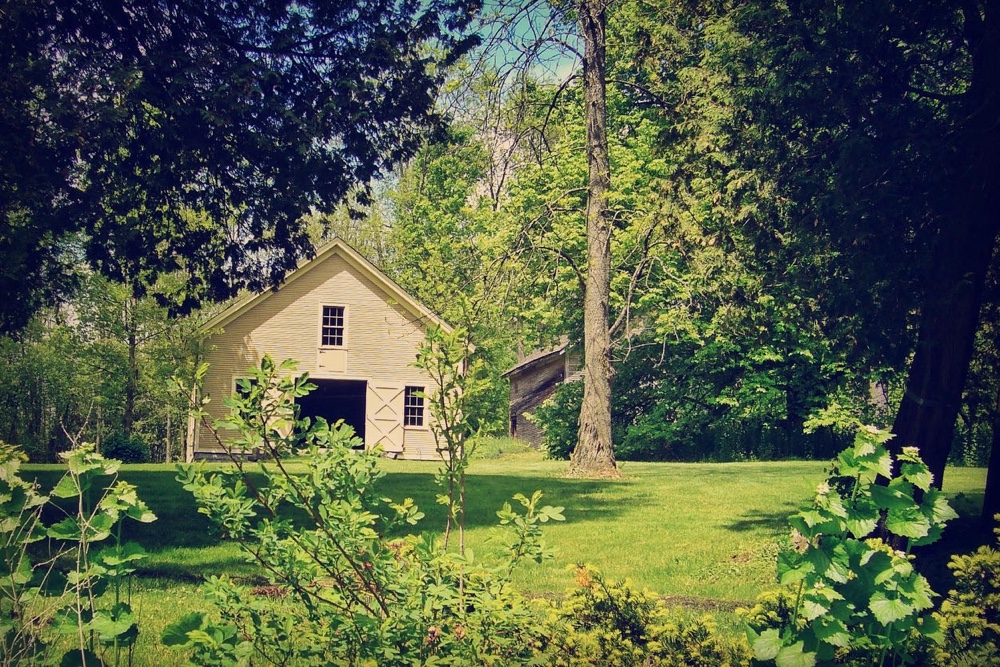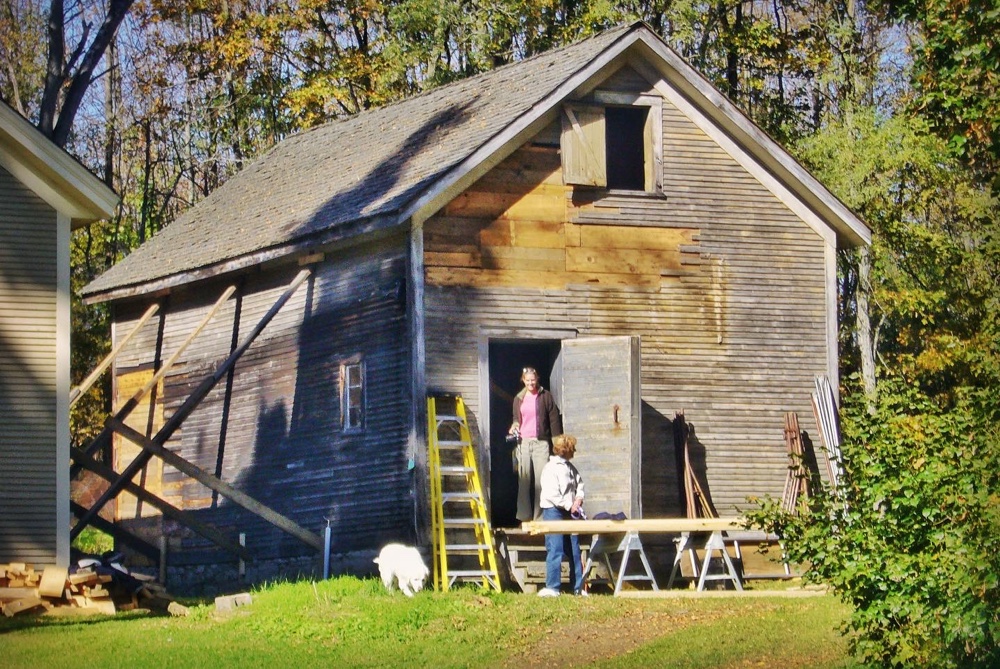
I’ve flitted around the topic of preservation by neglect on this blog for too long. I suppose that I’ve felt less comfortable putting my thoughts into writing than gabbing with friends similarly drawn to old buildings and artifacts. There’s a question of humility toward a topic better left to more scholarly authorities on historic preservation. And, to be perfectly candid, my appetite for preservation by neglect is perhaps a little unorthodox.
However, I’m currently resuscitating several blog post “orphans” — drafts initiated but left incomplete and unpublished over the years — that reveal some of the influences on my perspective of preservation by neglect, so it’s time to provide at least a perfunctory introduction to the idea. You may already have noted that many/most of my posts tend to tilt toward the lyrical and even the rhapsodic (i.e. “Icehouse On Ice“) rather than the historic, architectural, etc. Given this proclivity, how best to encapsulate and clearly communicate the idea of preservation by neglect? Why, defer to those better versed, of course!
What is Preservation by Neglect?
Time for me to get out of the way.
“Preservation by neglect,” is a term used to describe the way an old building is preserved by disrepair, thus the building’s original or historic features aren’t marred by a building owner that looks to make changes to an old building that are perceived as insensitive. — Elizabeth Blasius (Source: Historic Preservaton is Dead)
Pretty straightforward, right? Preservation by neglect generally refers to historic preservation of a building or area that happens accidentally, mostly because no active effort is made to alter, update, or demolish the structure(s).
Neglect can lead to a measure of preservation by default when there is no active maintenance or development pressures, and the countryside persists with very little change. This neglect can occur as a result of little or no economic pressures that would otherwise cause land values to increase and properties to be renovated. But the problem with accidental preservation by neglect is that it is not true preservation; it does not permanently protect resources from changes… — Robert Stanford (Source: Reading Rural Landscapes: A Field Guide to New England’s Past)
Limited economic means and population stasis or decline are frequently at the root of preservation by neglect, effectively reducing even eliminating the incentive to alter the existing built environment and potentially allowing for the possibility of permanent preservation in the future.
While I certainly don’t advocate preservation by neglect and prefer actual preservation, I’d rather the neglected buildings remain than be demolished. Particularly in downtown areas, there is a constant reminder of the past, the building’s important contribution to the streetscape, and what could be if the building were restored. If you tear down every empty building, then what? […] most importantly, there’s a loss of character and a sense of place. At least with the buildings remaining, there’s hope. Hope that they’ll be restored. Hope that downtown can be revitalized. Hope that the community’s uniqueness and pride can be retained. — Terri Fisher (Source: T Squared’s 4 Square)
Preservation by neglect is not necessarily a goal, nor is it a realistic solution for historic preservation, but in some cases it is a bridge from past to present that would have been lost given typical pressures from development, fashion, safety, etc.
Although sometimes considered a conservation strategy, this invests it with a greater degree of intention than I suspect is usually the case. Often historic buildings deteriorate because they are no longer necessary or desirable, or they’ve become too difficult or expensive to maintain, or conditions have become too precarious or dangerous to attempt renovation. Entropy. In some cases this inevitable natural deterioration resulting from human inaction can help protect a building from alteration, demolition, etc. that might otherwise permanently alter, damage, or eliminate the underlying architectural or cultural heritage. In essence, these forgotten properties, are spared by virtue of being too far gone for convenient rehabilitation. Their neglect has in some (but certainly not all) cases lead to eventual preservation. (Source: The Farm in Cossayuna)
In short, when active preservation (intervention with intent to historically preserve) is not a viable option for historic buildings and other architectural or cultural heritage, deliberate or inadvertant neglect, even when allowing the assets to continue deteriorating, is often an effective way to maintain the historic integrity and character of the property. Sometimes he best way to preserve a property is to simply do nothing.

Rosslyn’s Icehouse
Although an argument might be made that at different points in time all four of Rosslyn’s still extant buildings were subjects of preservation by neglect, significant efforts were made to preserve the home and the boathouse. Fortune more than anything seems to have safeguarded the carriage barn while so many other outbuildings vanished over the last century. But the icehouse is in my estimation the best example of preservation by neglect as I’ve explained in a previous post. Here’s the most relevant excerpt.
Although various reasons likely underpin the icehouse’s endurance, and the attentions of previous owners are no doubt high on this list, I would suggest that one of the reasons we’re now fortunate to undertake a purposeful re-imagination of this building is that it’s been preserved for more than a century, in large part, by neglect. First and foremost it wasn’t demolished to make way for other needs (such as the clay tennis court that adjoins its west and northwest flank). And it wasn’t adapted into a chicken coop or conjoined with the carriage barn or… It served a limited functional purpose for at least two previous owners that I’m aware of (one as part of honey-making accommodations and another as a woodworking shop), but the building wasn’t irretrievably bastardized to fulfill its temporary needs. (Source: Icehouse On Ice – Rosslyn Redux
I’ll sidestep the temptation to dilate previous comments by offering a couple of tidy clarifications on the most obvious risk with preservation by neglect.
Preservation vs. Demolition by Neglect
Inevitably neglect, extended neglect flirts with loss of the building(s). For this reason it is not a suitable preservation objective except when no other alternative is viable.
There is a fine line between preservation by neglect and demolition by neglect. A building that has been mothballed, or closed up with a tight roof and closed windows, locked doors, and a solid foundation, will remain a viable part of the streetscape through years of neglect. However, the minute the roof starts to leak, the windows are broken, or the doors are kicked in, demolition by neglect sets in. The building’s demise is heartbreaking to watch and is often the result of an equally sad situation such as bankruptcy or death of the owner or crime in the neighborhood. The final result is often a mandate from the municipality that the neglected building be demolished because it is hazardous to passerby. — Terri Fisher (Source: T Squared’s 4 Square)
And in even more straightforward terms:
In many urban areas, disinvestment has lead to the preservation by neglect of much of the historic fabric. When left for too long, this lack of interest becomes demolition by neglect and the structures are damaged beyond repair. — Rachel Royer (Source: Preserving Historic Character and Materials: An Analysis of Rehabilitation Projects of Habitat for Humanity)
In short, if historic preservation is the objective, preservation by neglect is at best a highly risky means to the end, and the risk is slow, irreversible demolition.
An Unorthodox Twist
I mentioned at the outset a somewhat peculiar penchant for preservation by neglect. My time and energy are dwindling so I’ll again draw on the post cited above.
The idea [of preservation by neglect] is baked into my love for and efforts toward rehabilitating old buildings, and it’s in many respects more compelling to me than the finished accomplishments of a preservation project. [Perhaps] it’s akin to my penchant for wabi-sabi. In my perspective there is profound beauty in the imperceptibly slow entropic forces revealed in aging, even failing, man-made artifacts. (Source: Icehouse On Ice – Rosslyn Redux
Don’t misunderstand. Susan and I have dedicated an monumental effort to preserving (actually rehabilitating) Rosslyn over the last sixteen years. The last thing we wanted was entropic victory! But in general, in the world at large, I find myself absolutely fascinated with the inevitable lifecycle of human artifacts. And I am almost always in favor of celebrating the imperfection and patina of longevity rather than masking the passage of time with inauthentic, ersatz makeovers. More on this another day.
Poetic Preservation by Neglect
In closing, I touched on the idea of initiated-but-neglected posts in my introduction. The overlap with the focus of this post intrigues me.
The earliest iteration of this originally somewhat melancholic reflection is nearly a decade old. Like many blog drafts it became an “orphan”, put aside for a day when my time was more abundant or my melancholy was less crowding or my thoughts were better gathered or… As with my poems, I frequently launch into a draft with the passion and clarity of purpose propelling me. And then, something stalls. And the initial foray falters. Or, at the very least, the seed for what I envision writing is cast aside indefinitely.
Often enough I circle back, allowing the persistent relevance of the idea, the recurring urgency to undergird a certain confidence that I might be on to something. That I need to revisit the seed, germinate it, nurture it. (Source: Icehouse On Ice – Rosslyn Redux)
And so it is that I fall back on my more poetic inclinations, more than content to leave the scholarly opining to my more academic peers. For me, the almost uncanny parallel between my creative drafts, too often neglected and often totally abandoned, and historic buildings kindles my curiosity. Hopefully yours, at least a little, as well.
What do you think?